How to use the TAN function
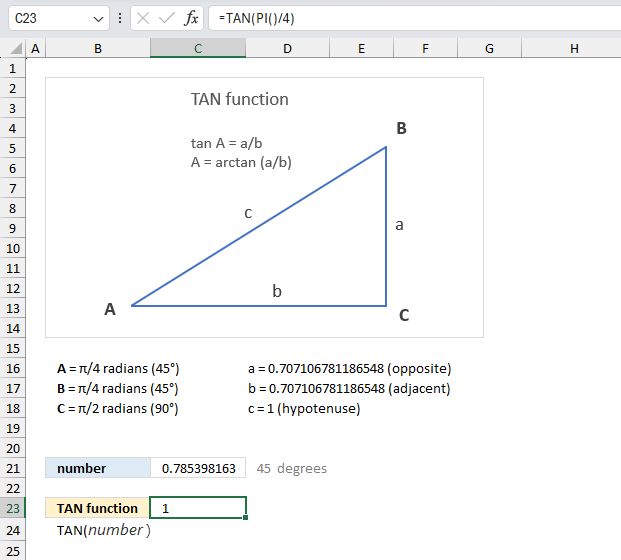
What is the TAN function?
The TAN function calculates the tangent of an angle in radians.
Table of Contents
1. Introduction
What is the trigonometric tangent?
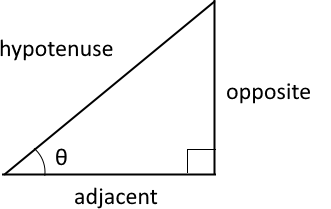
The tan is a trigonometric function that relates an angle θ in a right triangle to the ratio of the side lengths of a right triangle.
tan(θ) = opposite / adjacent
TANGENT θ is equal to the ratio between sides opposite and adjacent, this is only true if the triangle is a right-angled triangle.
What is a right triangle?
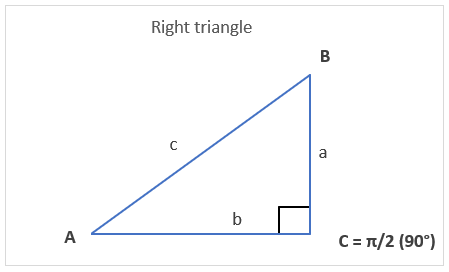
A right triangle must have one angle that measures exactly 90° or π/2 radians. The 90-degree angle is typically represented by a small square or a box in the corner of the angle.
This notation is used to indicate that the angle is a right angle which is π/2 radians or 90 degrees. The image above shows a small black square in the lower right corner of the right triangle.
What is the angle θ?
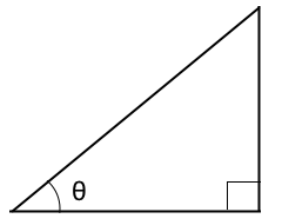
The Greek letter theta (θ) is commonly used to represent an unknown angle in a right triangle.
What is the connection between a circle with radius r and a right triangle?
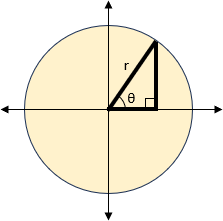
A circle with radius r is closely related to a right triangle because you can inscribe a right triangle within the circle. In fact, if you draw a radius from the center of the circle to the circle's edge, and then draw a perpendicular line from the edge to the x-axis, you'll create a right triangle with the radius as the hypotenuse.
This connection is fundamental in trigonometry, as it allows you to define the sine, cosine, and tangent functions using the ratios of the sides of the right triangle.
What is a radian?
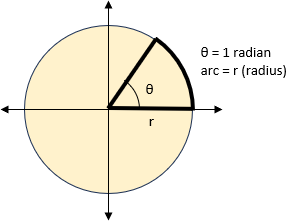
r = radius
θ = 1 radian
arc length = radius
Radians are a fundamental unit of measurement for angles. To be more specific, one radian is equivalent to the angle at the center of a circle that subtends an arc with a length equal to the radius of that circle. In other words, an angle of 1 radian has an arc length equal to the circle's radius.
A circle is 2π radians or 360 degrees. This means that if you were to measure the angle of a full circle in radians you would get 2π radians.
On the other hand, a half circle, which is 180 degrees, is equivalent to π (pi) radians. If you measure the angle of a half circle in radians you get π radians.
What is the relationship between the number pi and radians?
Radians measure angles by the length of the arc they make in a circle rather than degrees. The full circumference of any circle is 2π multiplied by the circle's radius (2πr).
Since the circumference goes all the way around a circle, that means the full circle measures 2π radians. Half a circle would be π radians (half of 2π). A quarter circle is 2π/4 = π/2 radians. An eighth of a circle is 2π/8 = π/4 radians.
Excel has a function that returns the number pi: PI function
What is an arc?
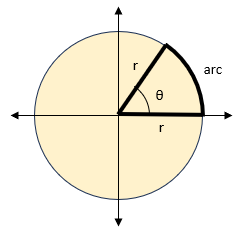
An arc is a curved segment of a circle's circumference, it is a portion of the circle's curve, defined by two endpoints.
In other words, an arc is formed by two radii intersecting the circumference and the enclosed edge between them.
What is a circle's radius?
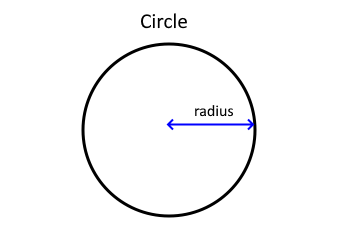
The radius of a circle is the distance from the center point to any point on the circle's edge or circumference.
What is radii?
The plural form of the word "radius".
What is the Pythagorean theorem?
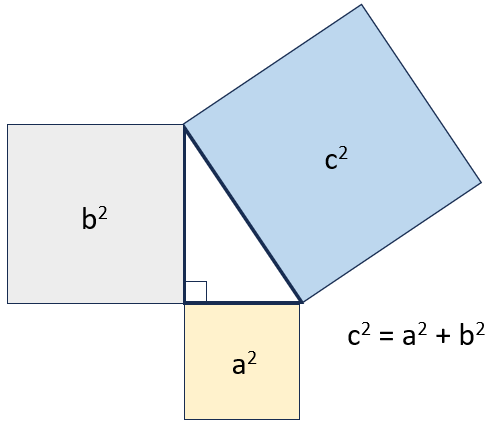
The Pythagorean theorem is a mathematical relationship between the sides of a right triangle. In a right triangle, the square of the hypotenuse is equal to the sum of the squares of the other two sides.
a2 + b2 = c2
a and b are the lengths of the legs of the triangle
c is the length of the hypotenuse
For example, in a triangle with legs 5 and 2:
√(52 + 22) = √(25 + 4) = √29
The hypotenuse is √29
What are the main trigonometric functions?
| Function | Domain (input) | Range (output) |
| sin(x) | All real numbers | (-1, 1) |
| cos(x) | All real numbers | (-1, 1) |
| tan(x) | All real numbers except multiples of π/2 | (-∞, ∞) |
| sec(x) | All real numbers except multiples of π | (1, ∞) U (-∞, -1) |
| csc(x) | All real numbers except integer multiples of π | (-∞, -1) U (1, ∞) |
| cot(x) | All real numbers except integer multiples of π | (-∞, ∞) |
2. Syntax
TAN(number)
| number | Required. The radian angle you want to know the tangent of. |
3. Example 1

Calculate the tangent of π/4 radians in a right triangle?
What we know:
- Angle A is π/4 which is 45 degrees
- tan A = a/b
- The triangle is a right triangle
Formula in cell C3:
The formula in cell C20 returns 1 which represents the tangent in a right triangle based on an angle of π/4 or 45 degrees. The tangent is the ratio between the opposite side (a) and the adjacent side (b).
Determine the opposite (a) if the adjacent side (b) is equal to 1 unit and the angle (A) is equal to π/4 radians?
Tangent A = a/b
Tangent π/4 = 1
1 = a/1
If the ratio 1 is equal to a/b then 1 = a/1
a = 1*1
a = 1
The opposite side (a) is 1 unit if angle A is π/4 (45 degrees) and the adjacent side (b) is 1 unit.
4. Example 2
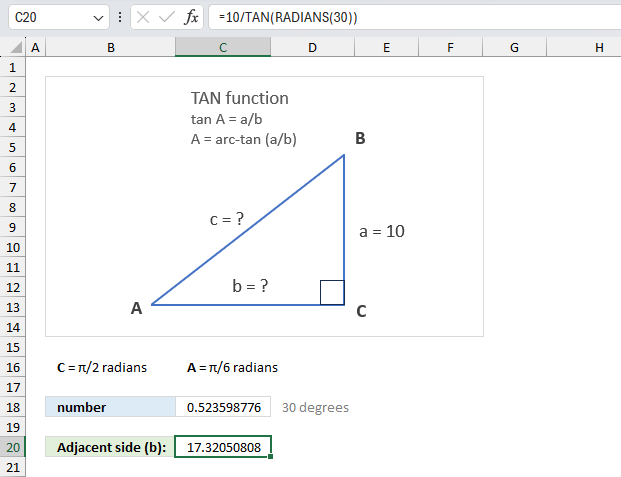
In a right triangle, if one acute angle measures 30 degrees and the opposite is 10 units long, find the length of the adjacent side?
What we know:
- The adjacent side (b) is unknown.
- Angle A is 30 degrees. We need to convert degrees to radians.
- The opposite side (a) is equal to 10 units.
- TAN A = a/b (opposite side / adjacent side)
Adjacent side (b) = a / SEC A
Formula in cell C20:
The result in cell C20 is 17.3205080756888 Here is how it is calculated:
- Convert degrees to radians. RADIANS(30) equals 0.523598775598299
- Calculate the tangent. TAN(RADIANS(30) equals 0.577350269189626
- Divide the opposite side to the tangent to get the length of the adjacent side (b).
10/TAN(RADIANS(30)) equals 17.3205080756888
The RADIANS function converts degrees to radians.
5. Example 3
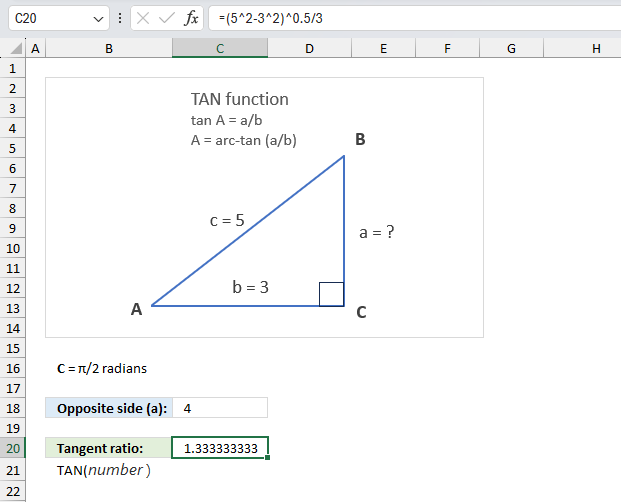
Calculate the tangent ratio if the adjacent side is 3 units and the hypotenuse is 4 units in a right triangle?
What we know:
- Right triangle
- The adjacent side (b) is 3.
- The hypotenuse (c) is 5.
- The Pythagorean theorem allows us to calculate the opposite side (a).
a2 + b2 = c2
a = √(c2 - b2) - The tangent ratio is opposite side (a)/ adjacent side (b). TAN A = a/b
Formula in cell C18:
The result is 4/3 which represents the tangent ratio opposite side (a)/ adjacent side (b). Here is how it is calculated:
- Square the hypotenuse . 5^2 = 25
- Square the adjacent side . 3^2 = 9
- Add the squared values. 25 - 9 = 16
- Calculate the square root of the sum. 16^0.5 = 4
We now know that the opposite is 4. All sides in the right triangle is now known. The tangent ratio is opposite side/ adjacent side which becomes 4 / 3. Cell C20 displays 4/3 in decimal form.
6. Function not working

The TAN function returns
- #VALUE! error if you use a non-numeric input value.
- #NAME? error if you misspell the function name.
- propagates errors, meaning that if the input contains an error (e.g., #VALUE!, #REF!), the function will return the same error.
6.1 Troubleshooting the error value

When you encounter an error value in a cell a warning symbol appears, displayed in the image above. Press with mouse on it to see a pop-up menu that lets you get more information about the error.
- The first line describes the error if you press with left mouse button on it.
- The second line opens a pane that explains the error in greater detail.
- The third line takes you to the "Evaluate Formula" tool, a dialog box appears allowing you to examine the formula in greater detail.
- This line lets you ignore the error value meaning the warning icon disappears, however, the error is still in the cell.
- The fifth line lets you edit the formula in the Formula bar.
- The sixth line opens the Excel settings so you can adjust the Error Checking Options.
Here are a few of the most common Excel errors you may encounter.
#NULL error - This error occurs most often if you by mistake use a space character in a formula where it shouldn't be. Excel interprets a space character as an intersection operator. If the ranges don't intersect an #NULL error is returned. The #NULL! error occurs when a formula attempts to calculate the intersection of two ranges that do not actually intersect. This can happen when the wrong range operator is used in the formula, or when the intersection operator (represented by a space character) is used between two ranges that do not overlap. To fix this error double check that the ranges referenced in the formula that use the intersection operator actually have cells in common.
#SPILL error - The #SPILL! error occurs only in version Excel 365 and is caused by a dynamic array being to large, meaning there are cells below and/or to the right that are not empty. This prevents the dynamic array formula expanding into new empty cells.
#DIV/0 error - This error happens if you try to divide a number by 0 (zero) or a value that equates to zero which is not possible mathematically.
#VALUE error - The #VALUE error occurs when a formula has a value that is of the wrong data type. Such as text where a number is expected or when dates are evaluated as text.
#REF error - The #REF error happens when a cell reference is invalid. This can happen if a cell is deleted that is referenced by a formula.
#NAME error - The #NAME error happens if you misspelled a function or a named range.
#NUM error - The #NUM error shows up when you try to use invalid numeric values in formulas, like square root of a negative number.
#N/A error - The #N/A error happens when a value is not available for a formula or found in a given cell range, for example in the VLOOKUP or MATCH functions.
#GETTING_DATA error - The #GETTING_DATA error shows while external sources are loading, this can indicate a delay in fetching the data or that the external source is unavailable right now.
6.2 The formula returns an unexpected value

To understand why a formula returns an unexpected value we need to examine the calculations steps in detail. Luckily, Excel has a tool that is really handy in these situations. Here is how to troubleshoot a formula:
- Select the cell containing the formula you want to examine in detail.
- Go to tab “Formulas” on the ribbon.
- Press with left mouse button on "Evaluate Formula" button. A dialog box appears.
The formula appears in a white field inside the dialog box. Underlined expressions are calculations being processed in the next step. The italicized expression is the most recent result. The buttons at the bottom of the dialog box allows you to evaluate the formula in smaller calculations which you control. - Press with left mouse button on the "Evaluate" button located at the bottom of the dialog box to process the underlined expression.
- Repeat pressing the "Evaluate" button until you have seen all calculations step by step. This allows you to examine the formula in greater detail and hopefully find the culprit.
- Press "Close" button to dismiss the dialog box.

There is also another way to debug formulas using the function key F9. F9 is especially useful if you have a feeling that a specific part of the formula is the issue, this makes it faster than the "Evaluate Formula" tool since you don't need to go through all calculations to find the issue..
- Enter Edit mode: Double-press with left mouse button on the cell or press F2 to enter Edit mode for the formula.
- Select part of the formula: Highlight the specific part of the formula you want to evaluate. You can select and evaluate any part of the formula that could work as a standalone formula.
- Press F9: This will calculate and display the result of just that selected portion.
- Evaluate step-by-step: You can select and evaluate different parts of the formula to see intermediate results.
- Check for errors: This allows you to pinpoint which part of a complex formula may be causing an error.
The image above shows cell reference B3 converted to hard-coded value using the F9 key. The TAN function requires numerical values which is not the case in this example. We have found what is wrong with the formula.
Tips!
- View actual values: Selecting a cell reference and pressing F9 will show the actual values in those cells.
- Exit safely: Press Esc to exit Edit mode without changing the formula. Don't press Enter, as that would replace the formula part with the calculated value.
- Full recalculation: Pressing F9 outside of Edit mode will recalculate all formulas in the workbook.
Remember to be careful not to accidentally overwrite parts of your formula when using F9. Always exit with Esc rather than Enter to preserve the original formula. However, if you make a mistake overwriting the formula it is not the end of the world. You can “undo” the action by pressing keyboard shortcut keys CTRL + z or pressing the “Undo” button
6.3 Other errors
Floating-point arithmetic may give inaccurate results in Excel - Article
Floating-point errors are usually very small, often beyond the 15th decimal place, and in most cases don't affect calculations significantly.
Functions in 'Math and trigonometry' category
The TAN function function is one of 62 functions in the 'Math and trigonometry' category.
How to comment
How to add a formula to your comment
<code>Insert your formula here.</code>
Convert less than and larger than signs
Use html character entities instead of less than and larger than signs.
< becomes < and > becomes >
How to add VBA code to your comment
[vb 1="vbnet" language=","]
Put your VBA code here.
[/vb]
How to add a picture to your comment:
Upload picture to postimage.org or imgur
Paste image link to your comment.
Contact Oscar
You can contact me through this contact form